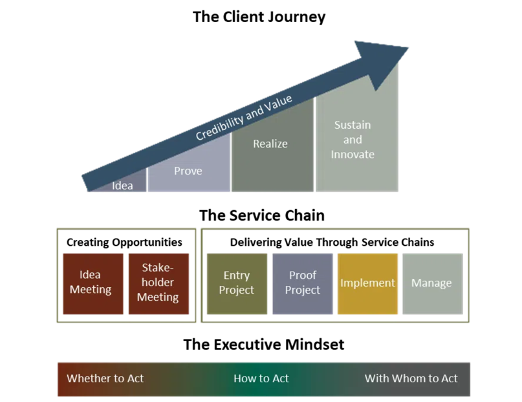In some of our recent blogs, we have discussed the importance of having your entire organization operate Above the Line of Safety, that is the level in an organization above which roles are empowered with budget and resources to independently solve a problem. Many organizations discuss this topic in terms of selling to executives or the C-Suite, a well-known and often attempted idea that is of course difficult to put into practice. In this blog, we will outline how to get above the Line of Safety using Service Chains and why the two ideas are inherently related.

Service Chains
Service Chains comprise a pre-defined set of sales activities and projects that collectively deliver your solution and value proposition in a manner that facilitates the buyer’s journey to understand, evaluate, and implement new ideas. The fundamental premise of the Service Chain is disaggregation of the big purchase decision (i.e., buying the total solution) into smaller decisions scoped and sized to match the buyer’s position in their purchasing journey – the buyer’s investment grows as the understanding, credibility, and value achieved or achievable increases.

Service Chains are the primary method to formalize the topics and ideas from the Portfolio into executable “how to play” offerings designed for differentiation, intimacy, and/or pull through. Specifically, Service Chains:
-
- Formalize the deliverables of the client engagements and use those deliverables to build credibility and intimacy
- Create a predictable stream of work that pulls through major revenue sources
- Reduce the overall sales investment and the risk – for both you and the buyer
- Provide the basis for account plans, communication plans, and executive interactions
- Support demand creation by aligning to the way that an executive makes a buying decision
How do Service Chains Help Get Above the Line of Safety?
The Service Chain frees the organization to go directly to the executive because it is geared to how the executive thinks. Often times, organizations create their offers with technical buyers below the Line of Safety in mind. These buyers act at the “With Whom to Act” stage. When organizations try to engage buying executives at the With Whom to Act stage, the executive is in many cases not interested because it is not a problem they are focused on. If they are interested, the selling organization must compete against others on price, features, etc.
Instead, by using Service Chains organizations can design entry projects that interest executives and open up discussions on problems they are focused on. Simultaneously, these offers are designed to meet the executive at a time when they are determining whether or not to act on the issue. Therefore, to get Above the Line of Safety, organizations need to create new Service Chain offers focused around a small first purchase that solves problems that plague executive buyers.
Conclusion
Working Above the Safety Line is both an offensive and defensive strategy. It allows protection from competitors because the selling organization now has higher value and greater intimacy. And, offensively, it provides a road to pull through the products and services that are more commoditized. Finally, the Service Chain provides a mechanism for many existing sales resources to work with executives without having to replace the sales force.
Written by: Anthony Paluska and Jack Draeb
Anthony Paluska is a Partner at McMann & Ransford with experience helping organizations overcome commoditization by developing stronger, more intimate, relationships with their customers. He has leveraged his management consulting, problem-solving, and change management skills to support 15+ Fortune 1000 organizations, across a multitude of industries.
Jack Draeb is a Senior Consultant with McMann & Ransford who has experience working with Fortune 1000 companies to identify issues, define solutions, guide change management, and deliver lasting results.
